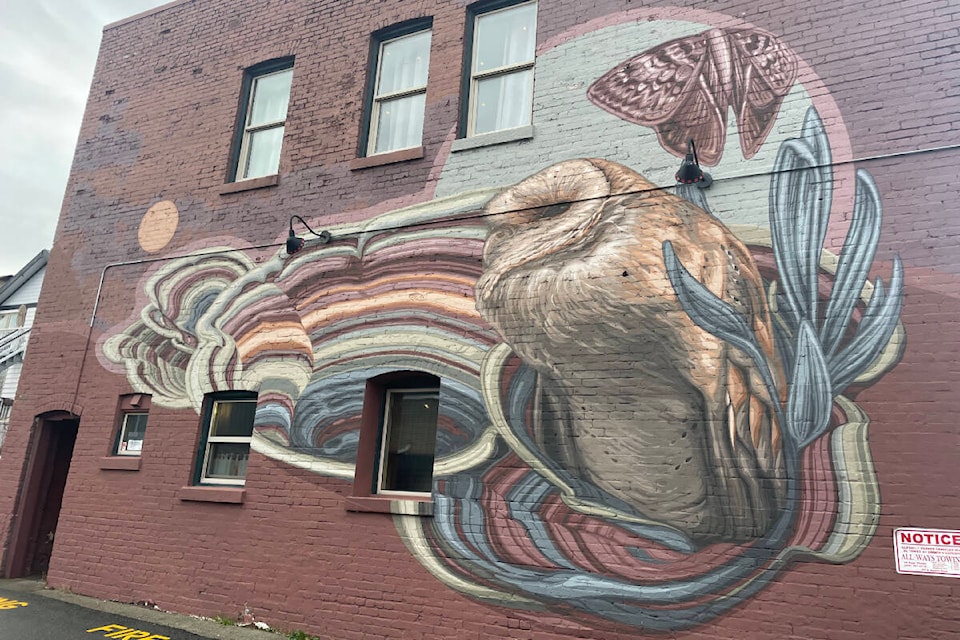Public art contributes culture, colour and connection to city centres, revitalizing neighbourhoods, pulling in new residents and healing communities, according to research.
Toronto’s 10-year public art strategy defines public art as “work in any medium that has been produced by an artist, installed in a publicly-accessible space.” Toronto is just one of hundreds that are pursuing more art in public spaces. Montreal and Vancouver have also been working to increase the amount of murals, temporary installations and sculptures.
From politicians to researchers, the consensus on public art remains that it deserves funding and focus, as it can have powerful impacts on everything from immigration and resident well-being to the economy.
Greater Victoria has benefited from programs that help fund public art such as My Great Neighbourhood and the Concrete Canvas initiative, which brought 17 local, national and international artists together to paint murals at 16 sites in Rock Bay. Additionally, Victoria has a mural roster and toolkit for those interested in creating a mural.
Still, Victoria City councillor, Matt Dell, wants to see more.
More mural happening in #yyj! This is the corner of Moss and Fairfield. We need to increase funding for public art across the city. pic.twitter.com/tTPbSMWvFC
— Matt Dell (@mattdellok) January 5, 2023
“Every community in my opinion, should be just covered in murals of different styles,” Dell said. “Some could be street art, some could be more clean, business art, some could be temporary, some could be permanent. We have a lot more work to do in Victoria to get there. I think public art just brings communities to life - it adds so much vibrancy and culture and life.”
With the cost of murals averaging around $2,000 and with larger pieces costing up to $5,000, government funding for artwork across the city is important, as most individuals and businesses can’t cover the costs necessary to make these projects happen.
“We’ve got some incredible mural artists in Victoria, so the people are there, but now we just need to really provide more support from city council and from businesses to try to get these artists that we have the funding that they need to do more art throughout the city,” Dell said.
READ MORE: Victoria’s outdoor art gallery celebrates young people and their passion
Additionally, if a business does have the money and time to front for a mural, they will often be representative of that business, rather than a piece of art that allows the artist to have full creative licence, limiting place-making that is associated with pieces that reflect the community.
Art reflecting Indigenous culture is just one form public art can take. Dell said that can contribute to reconciliation and community building.
“We are still understanding and working on reconciliation,” Dell said. “It is an active process but one small way of doing that is increasing the amount of Indigenous art across the city as a reminder that these lands are Indigenous lands where Indigenous people have been living for thousands of years and Indigenous art can remind us that the artists still live here today. It is just a daily reminder to people that reconciliation is work that we have to continue doing.”
But what merit does public art have for government funding? Why should public funds go to art projects?
For starters, Dell said grants and funding for public art bolsters support for local artists, but it also just ups a city’s cool factor.
READ ALSO: PHOTOS: Mural styles in Victoria run the gamut
“Murals simply make the city more cool - it just makes the city more interesting and more fun and more beautiful and more awesome,” Dell said. “I think we all agree that living in a city just covered in beige paint is not really that great.”
Over the course of the next year, Dell said his goal will be to advocate for a public arts funding increase in the 2023 budget cycle, acknowledging the time and money barriers to privately funding public art.
“One of the things I’d like to see is that the city undertake more of the Concrete Canvas-style projects,” he said. “They provide so much long-term value - this stuff was done in 2018 and it’s still around.”
Specifically, Dell wants to see an increase in dedicated funds for public art projects, either through grants or community projects and views public art as something that has a huge public benefit, warranting the use of public funds.
His calls for the public funding of art is often met with criticism and doubt, with many citing housing, food costs and high taxes as reasons why taxpayer money should go elsewhere, but Dell is steadfast in his belief that public art makes life better.
“We can’t view everything through an economic lens,” Dell said. “Public art makes people happy, reduces isolation and can even improve street safety.”
For Dell, who is a long-time supporter of the arts, this is a matter of the city’s heart, not wallet.
“It is the same as all art, how do you quantify what music does to people or what theatre does to people? It just kind of enhances humanity. Everybody benefits from public art and I think things that provide public benefit should be publicly funded. You get a big bang for your buck with public art, for $2,000 to $3,000, you can get an art piece that drastically improves a neighbourhood and I think that is good value for taxpayers’ money.”
READ ALSO: Greater Victoria residents invited to blessing of Indigenous mural celebrating solidarity
@HLFerguson
hollie.ferguson@vicnews.com
Like us on Facebook and follow us on Twitter.



